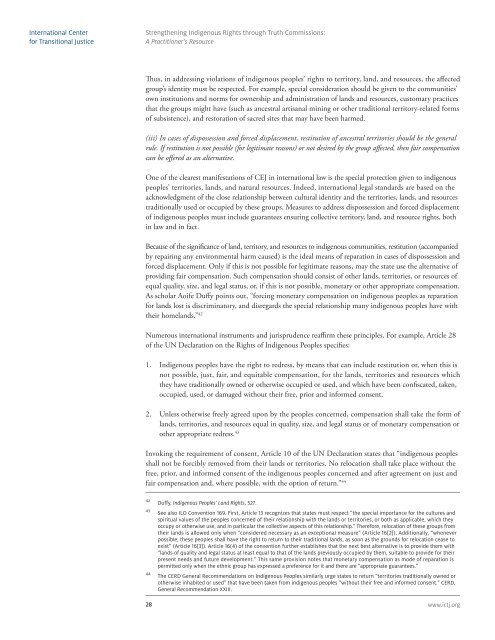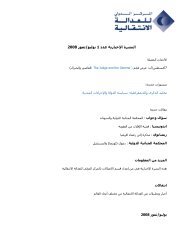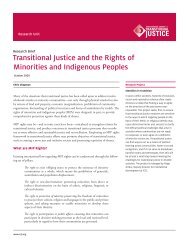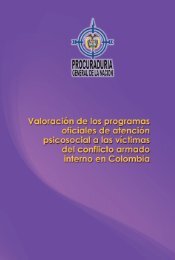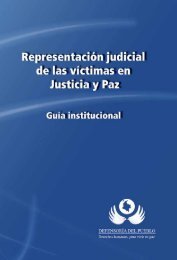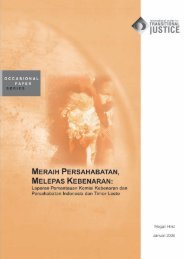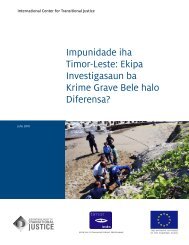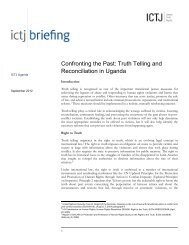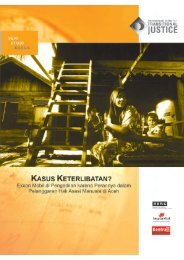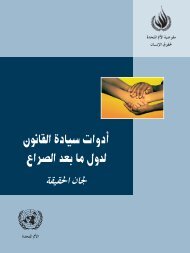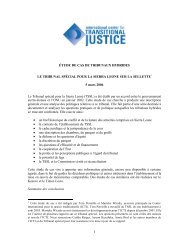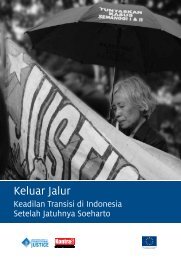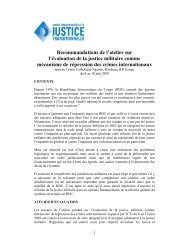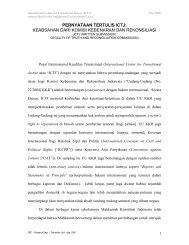Strengthening Indigenous Rights through Truth Commissions: A ...
Strengthening Indigenous Rights through Truth Commissions: A ...
Strengthening Indigenous Rights through Truth Commissions: A ...
- No tags were found...
Create successful ePaper yourself
Turn your PDF publications into a flip-book with our unique Google optimized e-Paper software.
International Centerfor Transitional Justice<strong>Strengthening</strong> <strong>Indigenous</strong> <strong>Rights</strong> <strong>through</strong> <strong>Truth</strong> <strong>Commissions</strong>:A Practitioner’s ResourceThus, in addressing violations of indigenous peoples’ rights to territory, land, and resources, the affectedgroup’s identity must be respected. For example, special consideration should be given to the communities’own institutions and norms for ownership and administration of lands and resources, customary practicesthat the groups might have (such as ancestral artisanal mining or other traditional territory-related formsof subsistence), and restoration of sacred sites that may have been harmed.(iii) In cases of dispossession and forced displacement, restitution of ancestral territories should be the generalrule. If restitution is not possible (for legitimate reasons) or not desired by the group affected, then fair compensationcan be offered as an alternative.One of the clearest manifestations of CEJ in international law is the special protection given to indigenouspeoples’ territories, lands, and natural resources. Indeed, international legal standards are based on theacknowledgment of the close relationship between cultural identity and the territories, lands, and resourcestraditionally used or occupied by these groups. Measures to address dispossession and forced displacementof indigenous peoples must include guarantees ensuring collective territory, land, and resource rights, bothin law and in fact.Because of the significance of land, territory, and resources to indigenous communities, restitution (accompaniedby repairing any environmental harm caused) is the ideal means of reparation in cases of dispossession andforced displacement. Only if this is not possible for legitimate reasons, may the state use the alternative ofproviding fair compensation. Such compensation should consist of other lands, territories, or resources ofequal quality, size, and legal status, or, if this is not possible, monetary or other appropriate compensation.As scholar Aoife Duffy points out, “forcing monetary compensation on indigenous peoples as reparationfor lands lost is discriminatory, and disregards the special relationship many indigenous peoples have withtheir homelands.” 42Numerous international instruments and jurisprudence reaffirm these principles. For example, Article 28of the UN Declaration on the <strong>Rights</strong> of <strong>Indigenous</strong> Peoples specifies:1. <strong>Indigenous</strong> peoples have the right to redress, by means that can include restitution or, when this isnot possible, just, fair, and equitable compensation, for the lands, territories and resources whichthey have traditionally owned or otherwise occupied or used, and which have been confiscated, taken,occupied, used, or damaged without their free, prior and informed consent.2. Unless otherwise freely agreed upon by the peoples concerned, compensation shall take the form oflands, territories, and resources equal in quality, size, and legal status or of monetary compensation orother appropriate redress. 43Invoking the requirement of consent, Article 10 of the UN Declaration states that “indigenous peoplesshall not be forcibly removed from their lands or territories. No relocation shall take place without thefree, prior, and informed consent of the indigenous peoples concerned and after agreement on just andfair compensation and, where possible, with the option of return.” 4442434428Duffy, <strong>Indigenous</strong> Peoples’ Land <strong>Rights</strong>, 527.See also ILO Convention 169. First, Article 13 recognizes that states must respect “the special importance for the cultures andspiritual values of the peoples concerned of their relationship with the lands or territories, or both as applicable, which theyoccupy or otherwise use, and in particular the collective aspects of this relationship.” Therefore, relocation of these groups fromtheir lands is allowed only when “considered necessary as an exceptional measure” (Article 16[2]). Additionally, “wheneverpossible, these peoples shall have the right to return to their traditional lands, as soon as the grounds for relocation cease toexist” (Article 16[3]). Article 16(4) of the convention further establishes that the next best alternative is to provide them with“lands of quality and legal status at least equal to that of the lands previously occupied by them, suitable to provide for theirpresent needs and future development.” This same provision notes that monetary compensation as mode of reparation ispermitted only when the ethnic group has expressed a preference for it and there are “appropriate guarantees.”The CERD General Recommendations on <strong>Indigenous</strong> Peoples similarly urge states to return “territories traditionally owned orotherwise inhabited or used” that have been taken from indigenous peoples “without their free and informed consent.” CERD,General Recommendation XXIII.www.ictj.org


